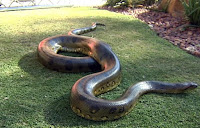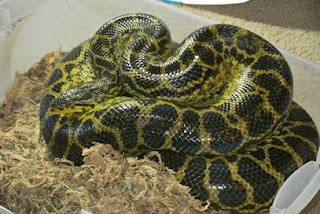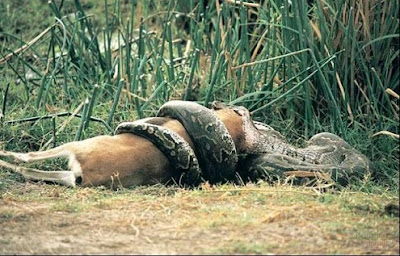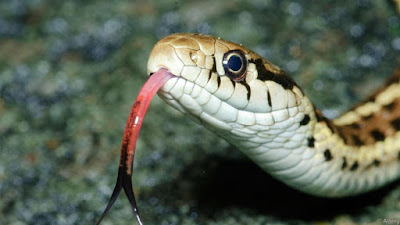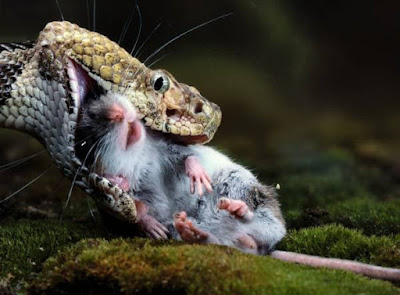 |
| The King Cobra |
The King Cobra Snake (Ophiophagus
hannah) is the largest venomous snake in the world. The King Cobra snake is
also perhaps the most dangerous snake in the world where humans are concerned. The
Ophiohagus Hannah has 11 largest scales on his head which resemble a king’s
crown, hence his majestic name. By the way, Ophiophagus is the latin word for “Snake
Eater”. Under conditions of high prey availability they can reach a length of
18.5 feet.The King, or Hamadryad, as he is sometimes called, holds the record
length of 24 feet for a Venomous snake.Several people
die from the bite of the King Cobra each year. A King Cobra can even kill an
elephant.
KING COBRA SNAKE HABITAT
 |
| King Cobra in the forest |
The King Cobra snake lives in much of mainland South
East Asia and throughout the dense highland forests. The King Cobra has a
preference for living in areas where there are lakes and streams as it is an
excellent swimmer. King Cobra populations have reclined in some areas of its
range due to the destruction of forests, however, despite this the snake is not
listed by the IUCN as in danger of becoming extinct. The King Cobra is said to
be the only snake which makes nests for its eggs. It is widely worshipped in
India as nagaraja (‘king of snakes’).
KING COBRA SNAKE BEHAVIOUR AND DIET
A Group of King Cobras is called a ‘Quiver’. Despite
the King Cobras fearsome reputation, it is generally a shy and reclusive
animal, avoiding confrontation with people as much as possible. There are many
smaller venomous snakes within this species range that are responsible for a
far greater number of fatal snake bites.
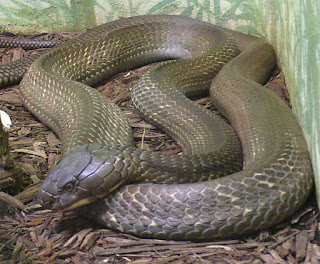 |
| The King Cobra |
The King Cobra snakes diet is mainly composed of
other snakes (ophiophagy – a specialized form of feeding or alimentary
behaviour of animals which hunt and eat snakes). The King Cobra snake prefers
non-venomous snakes, however, it will also eat other venomous snakes including
kraits and Indian Cobras. Cannibalism is not rare. When food is scarce, King
Cobras will also feed on other small vertebrates such as lizards. Like all
snakes, they swallow the prey whole, head first. The top and bottom jaws are
attached to each other with stretchy ligaments, which let the snake swallow
animals wider that itself. Snakes cannot chew their prey. Food is digested by
very strong acids in the snakes stomach. After a large meal the snake may live
for many months without another meal due to a very slow metabolic rate. King
Cobras are able to hunt at all times of day, although it is rarely seen at
night, leading some to debate whether it is a diurnal species.
King Cobras, like other snakes, smell using their
forked tongue which picks up scent particles and transfers them to a special
sensory receptor (Jacobson’s Organ), located in the roof of its mouth. When the
scent of a potential meal has been detected, the snake will continue to flick
its tongue to gauge the preys direction. It will also rely on its excellent
eyesight. The King Cobra snake is able to detect moving prey almost 300 feet
(100 metres) away. The King Cobra snake uses sensitivity to vibrations and
outstanding intelligence (compared to that of other cobra species) to track its
prey.
KING COBRA SNAKE REPRODUCTION
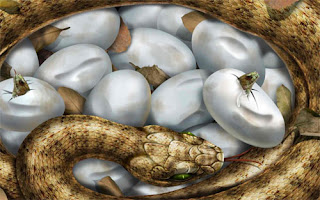 |
| King Cobra Eggs |
Breeding usually takes place in late spring or early
summer. After mating, the male will return back to its own home. The female
will then lay between 10 and 25 eggs. The offspring are independent as soon as
they are born and can capture prey the size of a rat.
Breeding takes place when the two snakes twist their
bodies together and can last for days in this position. Females wait
approximately 55 days before laying eggs. Female offspring are not bigger than
male offspring. The King Cobra snakes average life span is about 20 years.
KING COBRA SNAKE VENOM
The King Cobras venom is a neurotoxin, capable of
killing humans. The mortality rate can be as high as 75%, however, most bites
involve nonfatal amounts.
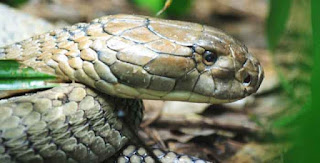 |
| King Cobra head. |
Their venom is not the most potent among venomous
snakes, however, the amount of neurotoxin they can deliver in a single bite –
up to two-tenths of a fluid ounce (seven millilitres) – is enough to kill 20
people, or even an elephant. Fortunately, king cobras are shy and will avoid
humans whenever possible. King Cobra snakes are fiercely aggressive when cornered
or provoked.
King Cobra venom, which is composed mostly of
proteins and polypeptides, is produced in specialized salivary glands just
behind the snakes eyes. When biting its prey, venom is forced through the
snakes half – inch – long (8 – 10 millimetre) fangs and into the wound.
Although the venom is less toxic than that of many other venomous snakes,
including the Indian Cobra, a King Cobra is capable of injecting more venom
than any other snake except the gaboon viper. In fact, a King Cobra can deliver
enough venom to kill a full-grown Asian Elephant in 3 hours.
King Cobra venom attacks the victims nervous system
and quickly induces severe pain, blurred vision, vertigo, drowsiness and
paralysis. In the minutes following, cardiovascular collapse occurs and the
victim falls into a coma. Death soon follows due to respiratory failure.

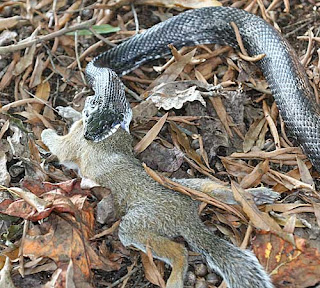 Habits: Adult rat snakes primarily eat mice, rats, squirrels, and
birds, as well as bird eggs. They are a common predator on wood duck eggs.
Juveniles eat small frogs, lizards, and small rodents. Rat snakes are
constrictors, and adept climbers that can scale brick walls as well as tree
trunks. When frightened they often assume a “kinked” posture and remain
motionless. They will vibrate the tail and expel malodorous musk.
Habits: Adult rat snakes primarily eat mice, rats, squirrels, and
birds, as well as bird eggs. They are a common predator on wood duck eggs.
Juveniles eat small frogs, lizards, and small rodents. Rat snakes are
constrictors, and adept climbers that can scale brick walls as well as tree
trunks. When frightened they often assume a “kinked” posture and remain
motionless. They will vibrate the tail and expel malodorous musk.

